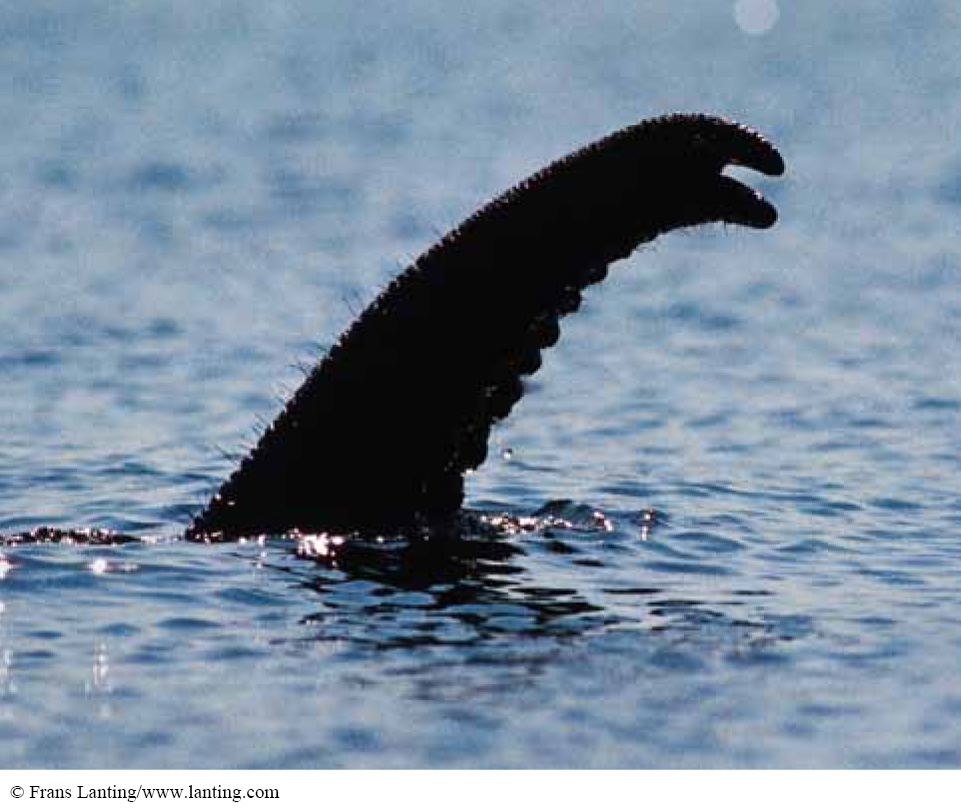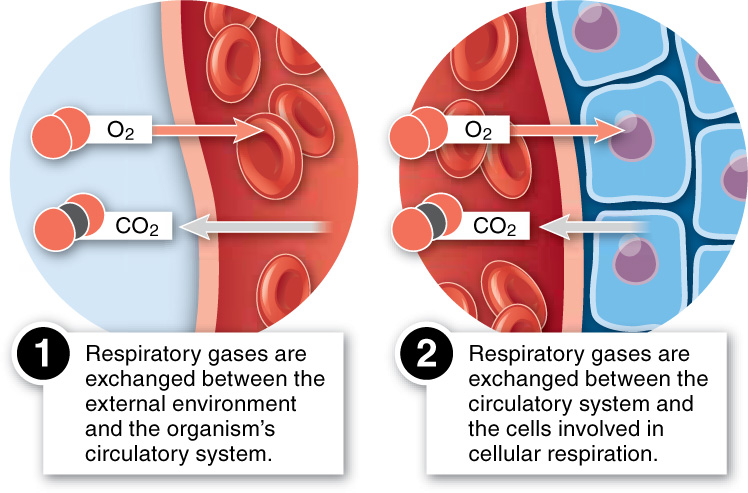21.12–21.17: The respiratory system enables gas exchange in animals.

An African elephant swimming across a river lifts its trunk to breathe.
21.12: Oxygen and carbon dioxide must get into and out of the circulatory system.

Figure 21.25: Overview of respiratory gas exchange in animals.

Figure 21.26: Gas-exchange systems and the body structures that support them.
As we’ve seen, circulatory systems are like trucking systems and the highways on which they move. Of the substances they transport, among the most important are the respiratory gases. After all, aerobic respiration requires cells to take up oxygen and release carbon dioxide. But how do these gases get into and out of the circulatory system? Where and how does gas exchange take place? In the rest of this chapter, we investigate the structures where gas exchange occurs and the transport molecules that make it possible.
In single-celled and very small multicellular organisms, gas exchange can occur by direct diffusion. In larger multicellular organisms, however, gas exchange becomes a two-stage process (FIGURE 21-25). First is the exchange between the external environment and the organism’s circulatory system. Later comes the exchange between the circulatory system and the cells involved in cellular respiration.
The first of these two stages can occur in several different types of organs specialized for respiration, such as lungs or gills. In all cases, however, it requires a respiratory medium—air or water—that serves as a reservoir for the gases, and a moist respiratory surface across which the gas exchange can occur. The many different systems that have evolved for gas exchange fall into five categories (FIGURE 21-26).
1. Direct diffusion. Single-celled organisms and many small multicellular organisms with low metabolic demands, such as marine flatworms, can accomplish respiration by direct diffusion between the cells and the environment.
2. Protruding respiratory sacs. Many slightly larger organisms also have low metabolic needs. Sea stars and other echinoderms have little balloon-like sacs that protrude from their skin—greatly increasing the surface area—and exchange gases between the body cavity and the environment.
3. Gills. Fishes and many aquatic invertebrates, such as lobsters and clams, have gills. These extensions of the body are tremendously elaborate structures in which the large surface area allows extensive exchange of gases between the water and the blood vessels of the circulatory system.
4. Tracheae. Although insect bodies look rather solid, they have a huge number of tiny openings—the spiracles—leading to tubes called tracheae that branch extensively throughout the body. These inner tubes make it possible for gases in the air to come in direct contact with most of the organism’s cells.
5. Lungs. Most land vertebrates have lungs. These are internal organs, characterized by highly branched, moist respiratory surfaces, across which gases in the air breathed in are exchanged with gases dissolved in the blood circulating through the lung tissue. Birds, reptiles, and mammals do virtually all of their respiration through their lungs, but amphibians (such as frogs) also exchange gases through their skin, which serves as a supplemental respiratory system. Their skin stays moist because of their largely aquatic lifestyle.
TAKE-HOME MESSAGE 21.12
In single-celled and very small multicellular organisms, gas exchange can occur by direct diffusion. In larger multicellular organisms, gas exchange is a two-stage process: (1) exchange between the external environment and the organism’s circulatory system, which usually takes place in lungs, tracheae, or gills, and (2) exchange between the circulatory system and the cells involved in cellular respiration.
Different organisms have evolved different mechanisms to facilitate gas exchange. Single-celled and small multicellular organisms, such as flatworms, can accomplish gas exchange through direct diffusion between their cells and the environment. Some slightly larger organisms, such as sea stars, have balloon-like respiratory sacs protruding from their skin that increase their surface area and facilitate gas exchange. List the three additional types of gas exchange.


